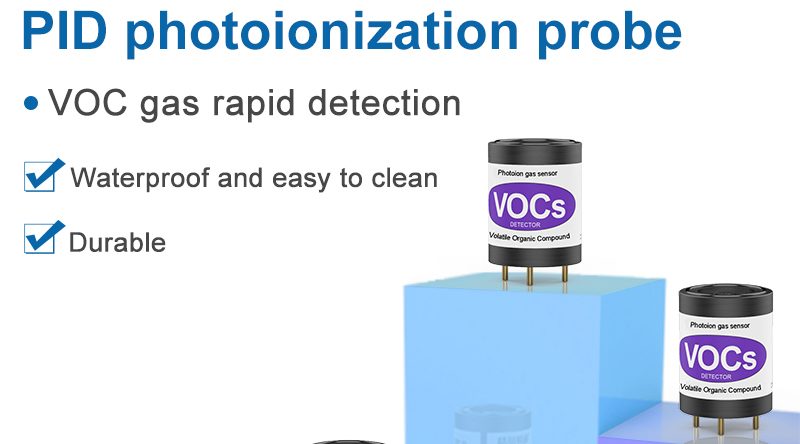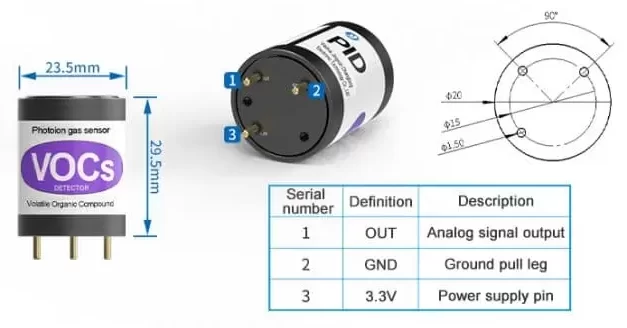Understand of VOC sensor
A VOC sensor, also known as a volatile organic compound sensor, is a device designed to detect and measure the presence of volatile organic compounds (VOCs) in the air. VOCs are a group of organic chemicals that can easily evaporate into the air at room temperature. They are emitted from a wide range of sources, including industrial processes, vehicle emissions, household products, and building materials. VOCs can have both short-term and long-term health effects on human health and can also contribute to environmental pollution and the formation of ground-level ozone .

VOC sensors are essential tools for monitoring indoor and outdoor air quality, as well as for identifying potential sources of VOC emissions. These sensors utilize various technologies to detect and quantify VOCs, providing valuable data for assessing air quality, identifying potential health risks, and implementing measures to reduce VOC exposure.
We can classify VOC sensors according to their detection principle and application, and each type has specific advantages and limitations. Some common types of VOC sensors include photoionization detectors (PID), metal oxide semiconductor (MOS) sensors, gas chromatography sensors, and infrared spectroscopy sensors.
Photoionization detectors (PID) are commonly use for the detection of VOCs in industrial and occupational settings. These sensors work by ionizing VOC molecules using ultraviolet light, which generates a measurable electrical current. PID sensors are highly sensitive and can detect a wide range of VOCs, making them suitable for identifying potential sources of contamination in industrial environments and assessing worker exposure levels.
Semiconductor sensors rely on the change in electrical conductivity of a metal oxide material when exposed to VOCs. As VOC molecules interact with the sensor’s surface, they cause a measurable change in resistance, which is then translated into a VOC concentration reading. Semiconductor sensors are cost-effective and suitable for applications such as indoor air quality monitoring and personal exposure assessments.
Gas chromatography sensors are highly accurate and precise instruments used for VOC analysis in laboratory settings. They work by separating VOCs based on their chemical properties and then detecting and quantifying individual compounds. Gas chromatography sensors are capable of identifying a wide range of VOCs with high sensitivity, making them valuable tools for environmental monitoring, industrial hygiene, and research applications.
Infrared spectroscopy sensors utilize the absorption of infrared light by VOC molecules to identify and quantify their presence in the air. These sensors are capable of detecting specific VOC compounds based on their unique infrared absorption spectra. Infrared spectroscopy sensors are widely used for industrial emissions monitoring, indoor air quality assessments, and environmental compliance monitoring.
The application of VOC sensors

The application of VOC sensor extends to a wide range of industries and settings. In industrial environments, VOC sensors are used to monitor emissions from manufacturing processes, chemical plants, and refineries. By continuously monitoring VOC levels, companies can identify potential leaks, spills, or equipment malfunctions, and take corrective actions to minimize environmental impact and ensure compliance with air quality regulations.
In indoor air quality monitoring, VOC sensor play a crucial role in assessing the potential health risks associated with indoor air pollution. Building materials, furniture, cleaning products, and personal care items can release VOCs into the indoor environment, leading to potential health concerns such as respiratory irritation, headaches, and allergic reactions. VOC sensors help identify sources of indoor air pollution and support the implementation of effective ventilation and air purification strategies to improve indoor air quality.
In addition to industrial and indoor applications, VOC sensors are also for outdoor air quality monitoring in urban areas, near roadways, and in proximity to industrial facilities. By continuously monitoring VOC levels in the ambient air, environmental agencies can assess the impact of vehicular emissions, industrial activities, and other sources of pollution on public health and the environment. This data can inform air quality management strategies, urban planning decisions, and public health interventions.
The development of advanced VOC sensor technologies has led to the integration of these sensors into portable, handheld, and wireless monitoring devices. These compact and versatile instruments enable real-time VOC monitoring in various settings, providing users with immediate feedback on air quality conditions and potential exposure risks. In occupational health and safety, portable VOC sensors are used for personal exposure monitoring, workplace assessments, and emergency response situations.
The importance of VOC sensors
The importance of VOC sensors in environmental protection and public health cannot be overstated. By providing accurate and reliable data on VOC concentrations, these sensors support informed decision-making, regulatory compliance, and the implementation of effective pollution control measures. Furthermore, VOC sensors contribute to public awareness of air quality issues and empower individuals and communities to take proactive steps to reduce VOC emissions and improve air quality.
In conclusion, VOC sensors play a critical role in monitoring and managing volatile organic compounds in the air. These sensors utilize various detection principles and technologies to provide accurate and reliable measurements of VOC concentrations, supporting environmental protection, public health, and regulatory compliance efforts. With their diverse applications in industrial, indoor, and outdoor settings, VOC sensors are essential tools for assessing air quality, identifying pollution sources, and safeguarding human health and the environment. As the development of VOC sensor technologies continues to advance, these instruments will remain indispensable for addressing air quality challenges and promoting sustainable and healthy living environments.